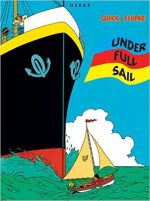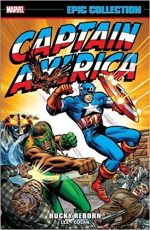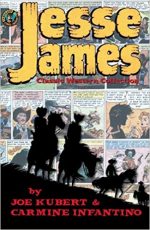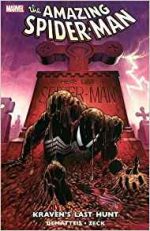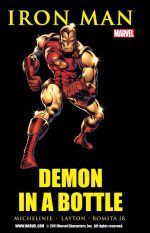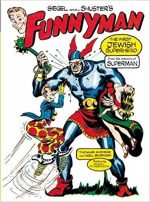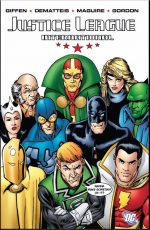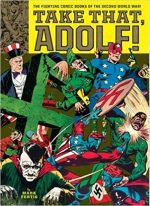
By Mark Fertig and many & various (Fantagraphics Books)
ISBN: 978-1-60699-987-5
Long the bastion of the arcane, historic, esoteric and the just plain interesting arenas of the comics experience, Fantagraphics Books here celebrates the dawn age of Fights ‘n’ Tights funnybooks with a magnificent collection of (mostly) superhero covers culled from the fraught period which most truly defined the comics industry.
Comicbook covers are a potent and evocative way of assessing the timbre of an era and a captivating shortcut into worlds far removed from our own. They are also half the sum total of fun generated by narrative art and arguably an art form all their own.
In this tome, educator, scholar and writer Mark Fertig (Chair of Art and Art History at Susquehanna University, Pennsylvania and revered film noir expert – check out his Where Danger Lives for more populist fun) offers an erudite and wide-reaching essay comprehensively addressing every aspect of the four-colour Home Front’s graphic endeavours in support of America’s WWII war effort.
Detailing how Jewish émigré artists’ and writers’ creative influences advocated America surrender its isolationist stance in ‘Four Color Fantasies’ and ‘Building Towards War’, Fertig then traces the development of ‘Red, White, and Blue Heroes’ such as The Shield and Uncle Sam before ‘The Coming of Captain America’ sparks the invention of ‘An Army of Captains’.
After the USA finally enters the war ‘All-Out Assault: August & September 1941’ is followed by an examination of female masked fighters in ‘She Can Do It!’ and reveals how Wonder Woman became ‘An Amazon for the Ages’.
‘Kids Can Fight Too!’ reveals the impact of junior and under-age crusaders as well as the sub-genre of Kid Gangs whilst ‘Attaboy, Steamboat!’ confronts head-on the depiction of ethnic characters – “evil†and Pro-democracy. From here in the distant future, some of the appalling jingoism and racism is even more disturbing than the tortures, torments and buckets of gore liberally scattered through the images of Evil Nazis and Japs…
Next ‘Into the Breach’ addresses the reasons omnipotent heroes such as Superman and Captain Marvel left the actual fighting in Europe and the Pacific to ordinary mortals before ‘Pulling Together’ details and the promotion of Home Front solidarity munitions manufacture and the arming of the armies of Freedom after which Hitler repeatedly gets his just deserts (in effigy at least) ‘In Der Führer’s Face!’
‘Soldiers, Sailors, Airmen, and Marines!’ follows the development of more human fictional soldiers and heroes whilst and ‘More Thrilling Than Fiction’ sees the begins of fact-based accounts of true champions such as President Roosevelt and General Eisenhower before ‘Pitch Men’ follows the numerous examples of masked warriors and kiddie-characters inciting readers to help pay for the war through selling war bonds and liberty stamps and ‘On to Victory’ celebrates the end of hostilities and the aftermath.
The fact-packed lecture is also supplemented at the back of the book by creator biographies of industry giants and iconic cover crafters Charles Clarence Beck, Jack Binder, Charles Biro, Hardin “Jack†Burnley, Reed Crandall, Will Eisner, Lou Fine, Irv Novick, Manuel “Mac†Raboy and Alex Schomburg (regarded as the most prolific cover illustrator of the period) but the true merit of this enchanting tome is the covers gathered for your perusal.
Designed to incite patriotic fervour and build morale, the awesome majority of this tome features a potent avalanche of stunning covers from almost every company, displaying not only how mystery men and superheroes dealt with the Axis of Evil in those tense times but also the valiant efforts of “ordinary fighting men†and even cartoon fantasy stars such as Bugs Bunny, Porky Pig and Walt Disney stars such as Mickey Mouse and Donald Duck…
Shopping List Alert: skip if you must…
This book celebrates an absolute cascade of spectacular, galvanising scenes of heroes legendary and obscure, costumed and uniformed, crushing tanks, swatting planes, sinking U-Boats and decimating enemy ranks, unleashed before your assuredly goggled eyes by artists long forgotten, and never known as well as more familiar names such as Joe Shuster, Joe Simon and Jack Kirby, Eisner, Harry G. Peter, Jack Burnley, Frank Harry, Irwin Hasen, Al Avison, Bob Powell, Edd Ashe, Harry Lucey, Paul Gustavson, Bill Everett, Jerry Robinson, Gus Ricca, Al Gabriele, Charles Sultan, Gene Fawcette, Louis & Arturo Cazeneuve, Gill Fox, Sam Cooper, Jim Mooney, Elmer Wexler, Fred Ray, Dan Zolnerowich, Don Rico, Max Plaisted, Howard Sherman, Everett E. Hibbard, Ramona Patenaude, Pierce Rice, Harry Anderson, Lin Streeter, Dan Gormley, Bernard Klein, Stephen Douglas, Martin Nodell, Charles Quinlan, Dan Noonan, Sheldon Moldoff, Henry Keifer, Marc Swayze, Carl Buettner, Charles A. Winter, Maurice, del Bourgo, Jack Warren, Bob Montana, Bob, Fujimori, Vernon Greene, George Papp, John Jordan, Syd Shores, John Sikela, Alex Blum, Ray Ramsey, R. Webster, Harry Sahle, Mort Leav, Alex Kotzky, Dan Barry, Al Camy, Stan Kaye, George Gregg, Art Saaf, George Tuska, alexander Kostuk, Al Carreno, Fred Kida, Ruben Moreira, Sidney Hamburg, Rudy Palais, Joe Doolin, Al Plastino, Harvey K. Fuller, Louis Ferstadt, Matt Bailey, Ham Fisher, Walt Kelly, Wayne Boring, John Giunta, Creig Flessel, Harold Delay, Lee Elias, Henry Boltinoff, L.B. Cole and George Marcoux plus many more who did their bit by providing safe thrills, captivating joy and astounding excitement for millions.
These powerful, evocative, charming, funny, thrilling, occasionally daft and often horrific images are controversial these days. Many people consider them Art with a capital ‘A’ whereas close-minded, reactionary, unimaginative, bigoted die-hard poltroons don’t.
Why not Dig back in time (For Victory!) and make your own decision?
© 2017 Fantagraphics Books, Inc. Main text© 2017 Mark Fertig. All comics covers and illustrations herein © 2017 the respective copyright holders All rights reserved.

